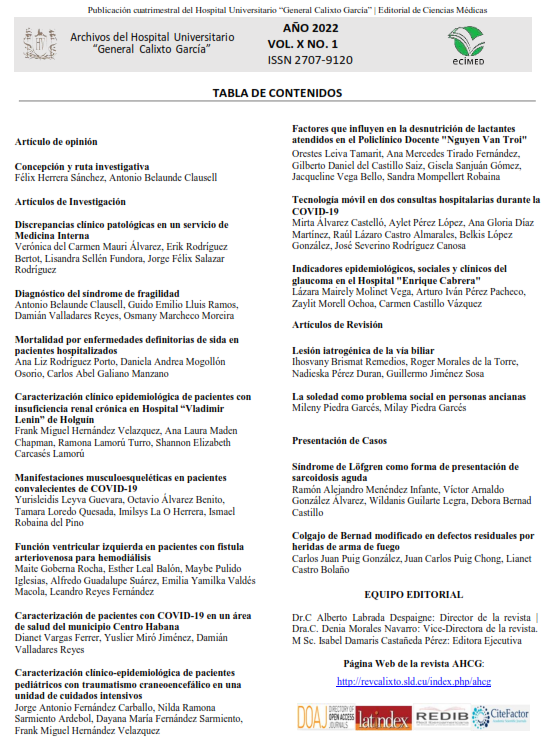Indicadores epidemiológicos, sociales y clínicos del glaucoma en el Hospital "Enrique Cabrera" / Epidemiological, social and clinical indicators of Glaucoma in "Enrique Cabrera" Hospital
Palabras clave:
glaucoma, género, indicadores, epidemiología.Resumen
Introducción: La incidencia de glaucoma es un problema actual de salud que compromete la calidad de vida de las personas. El género femenino representa la mayor prevalencia de ceguera en el mundo, por encima de los cuarenta años de edad. El glaucoma es la causa número uno de ceguera irreversible.Objetivo: Identificar los indicadores epidemiológicos, sociales y clínicos del glaucoma.
Métodos: Estudio transversal, descriptivo, desarrollado de enero 2021 a enero 2022, mediante la Encuesta 473, de 16 variables epidemiológicas, validada por el Departamento de Glaucoma del Hospital General Docente "Enrique Cabrera".
Resultados: Se incluyeron 50 pacientes, 50 % varones y resto mujeres. La evolución promedio fue 13 años del glaucoma, en control 86 %, con monoterapia de Timolol (colirio al 0,5 %) (56 %). Estuvo prevalente, en su mayoría, el glaucoma primario de ángulo abierto con 62 %. La comorbilidad más frecuente fue la hipertensión arterial sistémica 53 %. Hubo presencia de catarata en el 56 % de los casos.
Conclusiones: Se recaban como indicadores epidemiológicos, sociales y clínicos en el glaucoma, el número de fármacos empleados, la relación de familiares de primer nivel, la excavación evaluada y el color de la piel en los pacientes estudiados.
Descargas
Citas
Triana IC. Enfoque de género, salud y oftalmología. Rev Cubana MediSan 2013; 17(8):3093. Acceso:7/01/2021. Disponible en:http://scielo.sld.cu/scielo.php?script=sci_arttex&pid=S1029-30192013000800014.
Foo V, Tan S, Chen D, Perera S, Sabayanagam C, Fenwick E, et al. Areas and factors associated with patients; dissatisfaction with glaucoma care. OPTH 2017;Volume 11:1849–57.Access:8/01/2021. Available from:https://doi.org/10.2147/opth.s138668.
Quaranta L, Riva I, Gerardi C, Oddone F, Floriano I, Konstas AGP. Quality of Life in Glaucoma: A Review of the Literature. AdvTher 2016;33:959–81. Access:8/01/2021. Availablefrom:https://doi.org/10.1007/s12325-016-0333-6.
De-Gaulle VF, Dako-Gyeke P. Glaucoma awareness, knowledge, perception of risk and eye screening behaviour among residents of Abokobi, Ghana. BMC Ophthalmol 2016;16. Access:12/03/2021. Available from:https://doi.org/10.1186/s12886-016-0376-0.
Alemu DS, Gudeta AD, Gebreselassie KL. Awareness and knowledge of glaucoma and associated factors among adults: a cross sectional study in Gondar Town, Northwest Ethiopia. BMC Ophthalmol 2017;17. Access:11/04/2021. Available from:https://doi.org/10.1186/s12886-017-0542-z.
Tham Y-C, Li X, Wong TY, Quigley HA, Aung T, Cheng C-Y. Global Prevalence of Glaucoma and Projections of Glaucoma Burden through 2040. Ophthalmology 2014;121:2081–90. Access:05/06/2021. Available from:https://doi.org/10.1016/j.ophtha.2014.05.013.
Dubey S, Bedi H, Bedi M, Matah P, Sahu J, Mukherjee S, et al. Impact of visual impairment on the wellbeing and functional disability of patients with glaucoma in India. Journal of Current Ophthalmology 2019. Vol1. Pag9.Access:01/07/2021. Available from:https://doi.org/10.1016/j.joco.2019.09.006.
Singer L, Green M, Rowe F, Ben-Shlomo Y, Morrissey K. Social determinants of multimorbidity and multiple functional limitations among the ageing population of England, 2002–2015. SSM - Population Health 2019;8:100413. Access:01/07/2021. Available from:https://doi.org/10.1016/j.ssmph.2019.100413.
Ko Y-C, Hwang D-K, Chen W-T, Lee C-C, Liu CJ. Impact of Socioeconomic Status on the Diagnosis of Primary Open-Angle Glaucoma and Primary Angle Closure Glaucoma: A Nationwide Population-Based Study in Taiwan. PLoS ONE 2016;11:0149698. Access:02/07/2021. Available from:https://doi.org/10.1371/journal.pone.0149698.
Khandekar R, Chauhan D, Yasir ZH, Al-Zobidi M, Judaibi R, Edward DP. The prevalence and determinants of glaucoma among 40 years and older Saudi residents in the Riyadh Governorate (except the Capital) – A community based survey. Saudi Journal of Ophthalmology 2019;33:332–7. Access:09/08/2021. Available from:https://doi.org/10.1016/j.sjopt.2019.02.006.
Tricco AC, Thomas SM, Antony J, Rios P, Robson R, Pattani R, et al. Strategies to Prevent or Reduce Gender Bias in Peer Review of Research Grants: A Rapid Scoping Review. PLoS ONE 2017;12:0169718. Access:19/08/2021. Available from:https://doi.org/10.1371/journal.pone.0169718.
Mehari T, Giorgis AT, Shibeshi W. Level of adherence to ocular hypotensive agents and its determinant factors among glaucoma patients in Menelik II Referral Hospital, Ethiopia. BMC Ophthalmol 2016;16. Vol1. Pag16.Access:19/08/2021. Available from:https://doi.org/10.1186/s12886-016-0316-z.
Kizor-Akaraiwe NN, Monye HI, Okeke S. Awareness and knowledge about glaucoma and proportion of people with glaucoma in an urban outreach programme in Southeast Nigeria. BMJ Open Ophth 2017;1:000018. Access:23/08/2021. Available from:https://doi.org/10.1136/bmjophth-2016-000018.
Rhodes L, Huisingh C, McGwin G, Mennemeyer S, Bregantini M, Patel N, et al. Eye Care Quality and Accessibility Improvement in the Community (EQUALITY): impact of an eye health education program on patient knowledge about glaucoma and attitudes about eye care. PROM 2016:37. VOL1. Pag37Access:23/08/2021. Availablefrom:https://doi.org/10.2147/prom.s98686.
Killeen OJ, MacKenzie C, Heisler M, Resnicow K, Lee PP, Newman-Casey PA. User-centered Design of the eyeGuide. Journal of Glaucoma 2016;25:815–21. Access:29/08/2021. Available from:https://doi.org/10.1097/ijg.0000000000000431.
Sitkin NA, Pachankis JE. Specialty Choice Among Sexual and Gender Minorities in Medicine: The Role of Specialty Prestige, Perceived Inclusion, and Medical School Climate. LGBT Health 2016;3:451–60. Access:29/08/2021. Available from:https://doi.org/10.1089/lgbt.2016.0058.
Harling G, Chanda MM, Ortblad KF, Mwale M, Chongo S, Kanchele C, et al. The influence of interviewers on survey responses among female sex workers in Zambia. BMC Med Res Methodol 2019;19. Access:05/09/2021. Available from:https://doi.org/10.1186/s12874-019-0703-2.
Zhang Y, Jin G, Fan M, Lin Y, Wen X, Li Z, et al. Time trends and heterogeneity in the disease burden of glaucoma, 1990-2017: a global analysis. Journal of Global Health 2019;9. Access:06/09/2021. Available from:https://doi.org/10.7189/jogh.09.020436.
Harasymowycz P, Birt C, Gooi P, Heckler L, Hutnik C, Jinapriya D, et al. Medical Management of Glaucoma in the 21st Century from a Canadian Perspective. Journal of Ophthalmology 2016;2016:1–22. Access:09/09/2021. Available from:https://doi.org/10.1155/2016/6509809.
Newman-Casey PA, Niziol LM, Mackenzie CK, Resnicow K, Lee PP, Musch DC, et al. Personalized behavior change program for glaucoma patients with poor adherence: a pilot interventional cohort study with a pre-post design. Pilot Feasibility Stud 2018;4. Vol1. Pag6.Access:18/10/2021. Available from:https://doi.org/10.1186/s40814-018-0320-6.
McMonnies CW. Intraocular pressure and glaucoma: Is physical exercise beneficial or a risk? Journal of Optometry 2016;9:139–47. Access:18/10/2021. Available from:https://doi.org/10.1016/j.optom.2015.12.001.
Bar-David L, Blumenthal EZ. Evolution of Glaucoma Surgery in the Last 25 Years. Rambam Maimonides Med J 2018;9:0024. Access:19/10/2021. Available from:https://doi.org/10.5041/rmmj.10345.
Kyari F, Chandler CI, Martin M, Gilbert CE. So let me find my way, whatever it will cost me, rather than leaving myself in darkness: experiences of glaucoma in Nigeria. Global Health Action 2016;9:31886. Access:19/10/2021. Available from:https://doi.org/10.3402/gha.v9.31886.
Sayner R, Carpenter DM, Blalock SJ, Robin AL, Muir KW, Hartnett ME, et al. Accuracy of Patient-reported Adherence to Glaucoma Medications on a Visual Analog Scale Compared With Electronic Monitors. Clinical Therapeutics 2015;37:1975–85.Access:16/11/2021. Available from:https://doi.org/10.1016/j.clinthera.2015.06.008.
Alzuhairy SA. Chronic angle closure glaucoma: presentation and outcomes at a tertiary eye hospital of Saudi Arabia. IntSurg J 2018;6:73. Access:17/11/2021. Available from:https://doi.org/10.18203/2349-2902.isj20185066.
Bizuneh ZY, Tsega A, Addis Y, Admassu F.
Awareness of Glaucoma and Associated Factors Among Adults in Gish Abay Town, Northwest Ethiopia
. OPTO 2020;Volume 12:37–43. Access:21/11/2021. Available from:https://doi.org/10.2147/opto.s235538.Zeng L, Hark LA, Johnson D, Berardi G, Patel N, Dai Y, et al. A randomized, controlled trial to test the effectiveness of a glaucoma patient navigator to improve appointment adherence. PPA 2016;Volume 10:1739–48. Access:28/11/2021. Available from:https://doi.org/10.2147/ppa.s108391.
Sleath B, Blalock SJ, Carpenter DM, Sayner R, Muir KW, Slota C, et al. Ophthalmologist–Patient Communication, Self-efficacy, and Glaucoma Medication Adherence. Ophthalmology 2015;122:748–54. Access:28/11/2021. Available from:https://doi.org/10.1016/j.ophtha.2014.11.001.
Cohen Castel O, Keinan-Boker L, Geyer O, Milman U, Karkabi K. Factors associated with adherence to glaucoma pharmacotherapy in the primary care setting. Family Practice 2014;31:453–61. Access:29/11/2021. Available from:https://doi.org/10.1093/fampra/cmu031.
Shadid A, Alrashed W, Bin Shihah A, Alhomoud A, Alghamdi M, Alturki A, et al. Adherence to Medical Treatment and Its Determinants Among Adult Saudi Glaucoma Patients in Riyadh City. Cureus 2020. Vol1. Pag 10Access:29/11/2021. Available from:https://doi.org/10.7759/cureus.6847.
Publicado
Cómo citar
Número
Sección
Licencia
Aquellos autores/as que tengan publicaciones con esta revista, aceptan los términos siguientes:
- Los autores/as conservarán sus derechos de autor y garantizarán a la revista el derecho de primera publicación de su obra, el cuál estará simultáneamente sujeto a la Licencia Creative Commons Atribución– No Comercial 4.0 que permite el uso, distribución y reproducción no comerciales y sin restricciones en cualquier medio, siempre que sea debidamente citada la fuente primaria de publicación.
- Los autores/as podrán adoptar otros acuerdos de licencia no exclusiva de distribución de la versión de la obra publicada (p. ej.: depositarla en un archivo telemático institucional o publicarla en un volumen monográfico) siempre que se indique la publicación inicial en esta revista.
- Se permite y recomienda a los autores/as difundir su obra a través de Internet (p. ej.: en archivos telemáticos institucionales o en su página web) antes y durante el proceso de envío, lo cual puede producir intercambios interesantes y aumentar las citas de la obra publicada.









